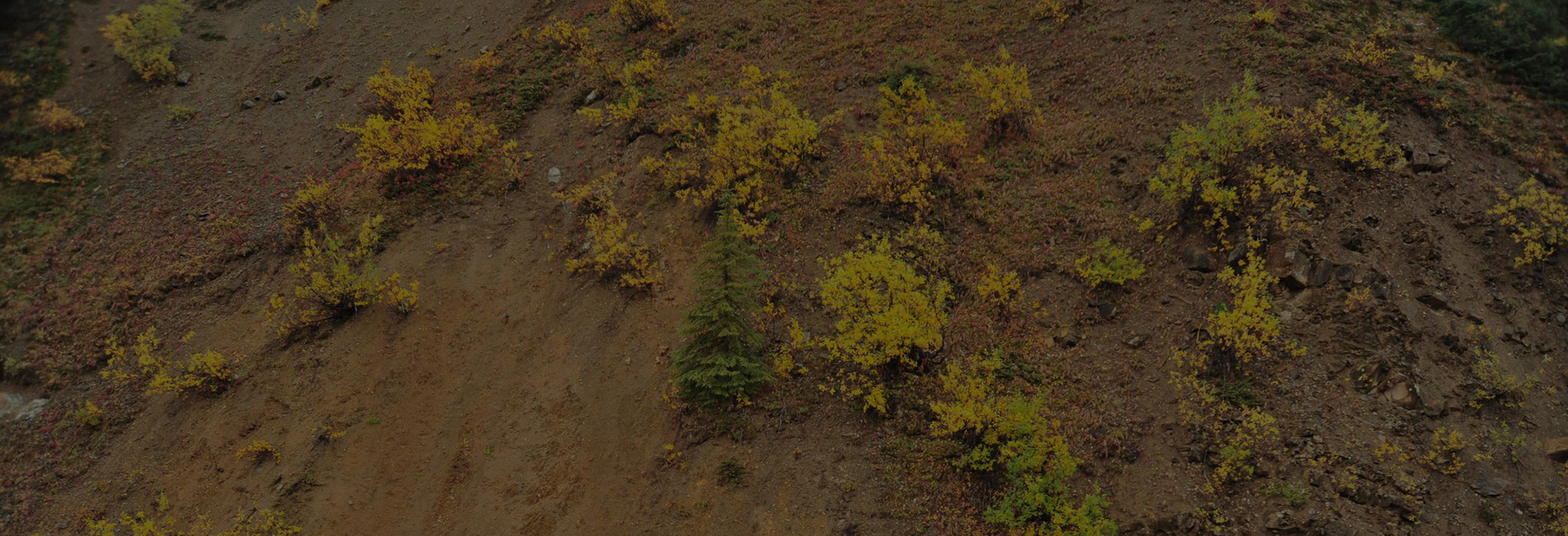- Hole V-23-048 returned 2.20 g/t Au over 265.2 m including 3.28 g/t Au over 100.2 m from surface (with the top 30.2 m averaging 5.03 g/t Au) in a 100 m step across strike to SW from previous hole V-23-039
- Hole V-23-045 returned 1.14 g/t Au over 517.9 m from surface in 102 m step across strike to NE from previous hole V-23-037, adding significant scale that remains open
- Multiple additional holes at Rogue Project’s Valley target demonstrate large intervals of strong mineralization outside the edges of previously known mineralization.
Vancouver, B.C., September 11, 2023: SNOWLINE GOLD CORP (TSX-V: SGD) (OTC: SNWGF) (the “Company” or “Snowline”) is pleased to announce additional analytical results from its ongoing drill program at the Valley target on its Rogue Project in Canada’s Yukon Territory. All ten holes encountered mineralization, with the nine holes drilled inside the intrusion returning continuous mineralization over downhole intervals ranging from 143.2 m to 517.9 m in length. Holes V-23-045 and V-23-048 returned 517.9 m of 1.14 g/t Au and 265.2 m of 2.20 g/t Au respectively, from surface. This expands the width of the high-grade, near surface core seen in previous holes, while V-23-045 also extends the depth of known mineralization in the east. Other holes add substantial volumes of known mineralization to the margins of the system as currently tested. Analytical results for an additional 19 holes (7,116 m) at Valley are pending, with drilling at Valley and other Rogue Project targets ongoing.
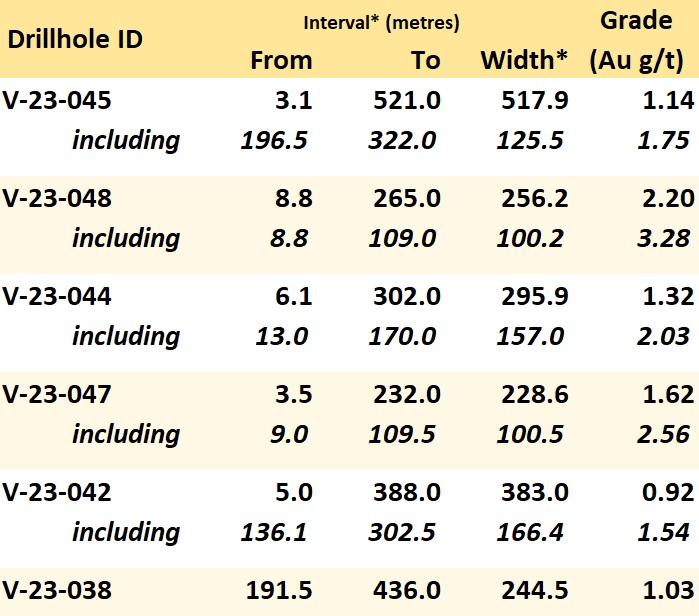
Table 1 – Highlight summary of Snowline’s latest assay results. *Interval widths reported; true widths of the system are not yet known.
“This latest round of results from our Rogue Project’s Valley target demonstrates high continuity of mineralization in three dimensions and adds considerable scale to the extent of the known system, which remains open,” said Scott Berdahl, CEO & Director of Snowline. “These holes primarily tested undefined margins of the well-mineralized corridor within the Valley intrusion. That they returned such strong grades—with holes running at multiples of the 0.64 g/t Au and 0.37 g/t Au average reserve grades seen at the nearest operating mines of this type, across hundreds of metres—speaks to the unique nature of the Valley discovery amongst reduced intrusion-related gold systems and among bulk tonnage gold systems in general. With two rigs currently active on the target and one more on the nearby Gracie target, we look forward to learning much more about these targets in the coming months.”
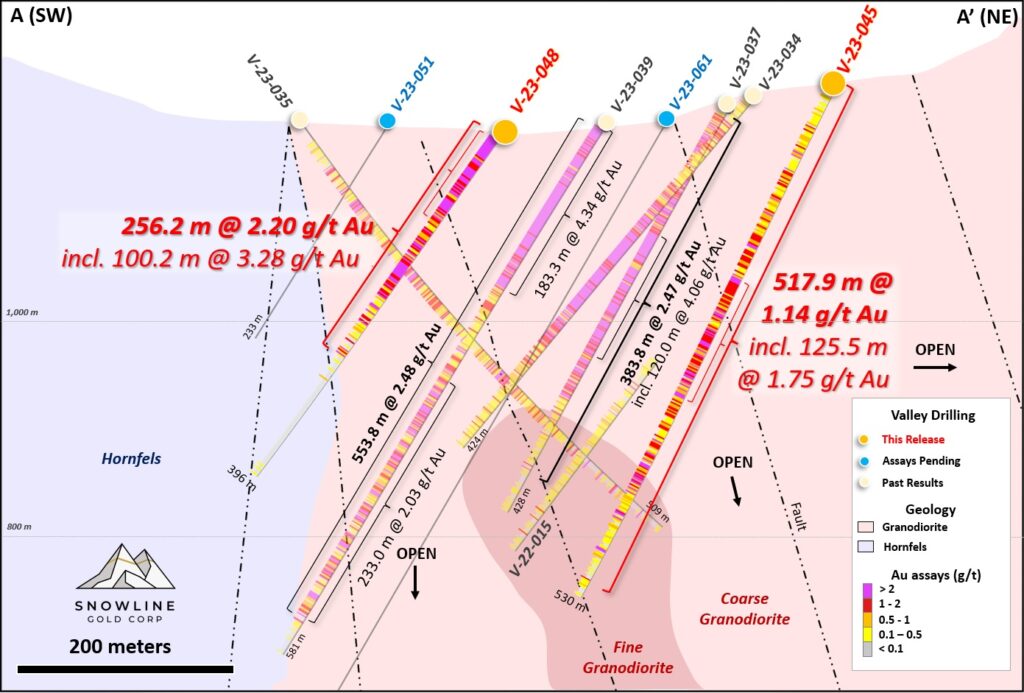
Figure 1 – Cross-section A, highlighting noteworthy continuity of strong, near-surface gold grades encountered at Valley. Holes V-23-045 and V-23-048 bookend analytical results received to date on this section with long intervals of robust mineralization. Hole V-23-045 is the northeastern-most hole drilled into the well-mineralized, near-surface corridor at Valley, demonstrating a >400 m width to the system that remains open. The hole also shows a continuity of mineralization to vertical depths of over 400 m below surface. Blank drill traces show where results are still pending. Note that V-22-035 sits in the foreground of the section—V-23-045 and 048 are herein plotted without interruption to highlight the recent results.
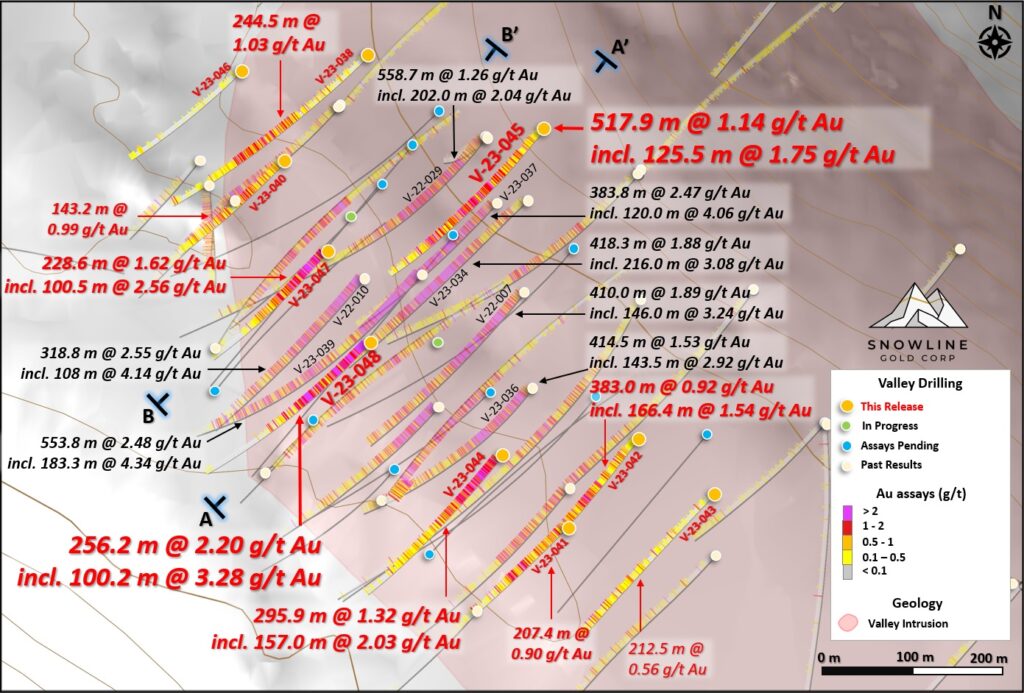
Figure 2 – Plan view of the Rogue Project’s Valley target showing analytical results from previous and current drilling, along with approximate traces of current holes. Current results, drilled primarily as step-outs from previous highlight holes, demonstrate the scale and the wide distribution of unusually high grades for a reduced intrusion-related gold system at Valley, with most intervals beginning at or near surface. The system remains open to the north and at depth, with more than 7,100 m of assays from Valley still pending and two drill rigs active on the target.
HOLE V-23-045
Hole V-23-045 is collared within the Valley intrusion as a 100 m step back along section from V-23-037 (383.3 m @ 2.47 g/t Au from surface including 120.0 m @ 4.06 g/t, see Snowline news release dated August 3, 2023). This step direction is perpendicular to the dominant trend of mineralization, which strikes northwest-southeast. Thus the results add to the previously known width of the system, which remains open. The hole is collared 67 m from the nearest hole, V-22-029 (558.7 g/t Au @ 1.26 g/t Au, see Snowline news release dated February 24, 2023). The hole ends in patchy lower grade mineralization and fault gauge within a fine-grained, porphyritic phase of the granodiorite (Figure 1).
The hole encountered a continuous zone of quartz vein mineralization in granodiorite over 517.9 m downhole from bedrock surface at 3.1 m, averaging 1.14 g/t Au along this length and showing a high degree of continuity. Within this zone, a 125.5 m downhole interval beginning at 196.5 m averages 1.75 g/t Au. Another interval of 16.5 m downhole beginning at 406.0 m depth averages 5.07 g/t Au. Instances of trace visible gold were noted in quartz veins throughout the length of the hole. Capping grades at 10.0 g/t Au reduces the average grade of mineralization within the broader interval only 2.4% to 1.11 g/t Au.
V-23-045 is the northeastern-most hole testing Valley’s well-mineralized corridor to date, and it extends the envelope of known >1 g/t Au mineralization considerably in this direction, where it still remains open. The hole also carries mineralization to depth, further expanding the known vertical footprint and highlighting the vertical exploration potential within the Valley intrusion.
HOLE V-23-048
Hole V-23-048 is collared within the Valley intrusion as a 95 m step along section to the southwest of V-23-039 (553.8 m @ 2.48 g/t Au, Snowline news release dated August 3, 2023). The hole is collared 72 m south of the nearest hole, V-22-010 (318.8 m @ 2.55 g/t Au including 108.0 m @ 4.14 g/t Au from surface, see Snowline news release dated October 12, 2022).
Mineralization within V-23-048 is robust and consistent, averaging 2.20 g/t Au over 256.2 m, including a higher-grade zone averaging 3.28 g/t Au over 100.2 m from bedrock surface at 8.8 m downhole. The top 30.2 m of the hole, measured downhole from bedrock surface, averages 5.03 g/t Au. As with many other holes at Valley, this grade profile sees the highest grades of the system beginning at surface. Despite the high grades, only one assay exceeded 10 g/t Au (10.1 g/t Au over 1.0 m from 23.0 m downhole). Grade capping at 10.0 g/t thus has virtually no effect on results. As with other holes seen at Valley, this underscores the remarkable grade continuity within the system.
The hole crosscuts abundant sheeted quartz veins within the intrusion, in places carrying trace amounts of visible gold within the veins. It exits the intrusion into lightly mineralized hornfels and a series of 1-2 m wide dikes at 255.9 m downhole.
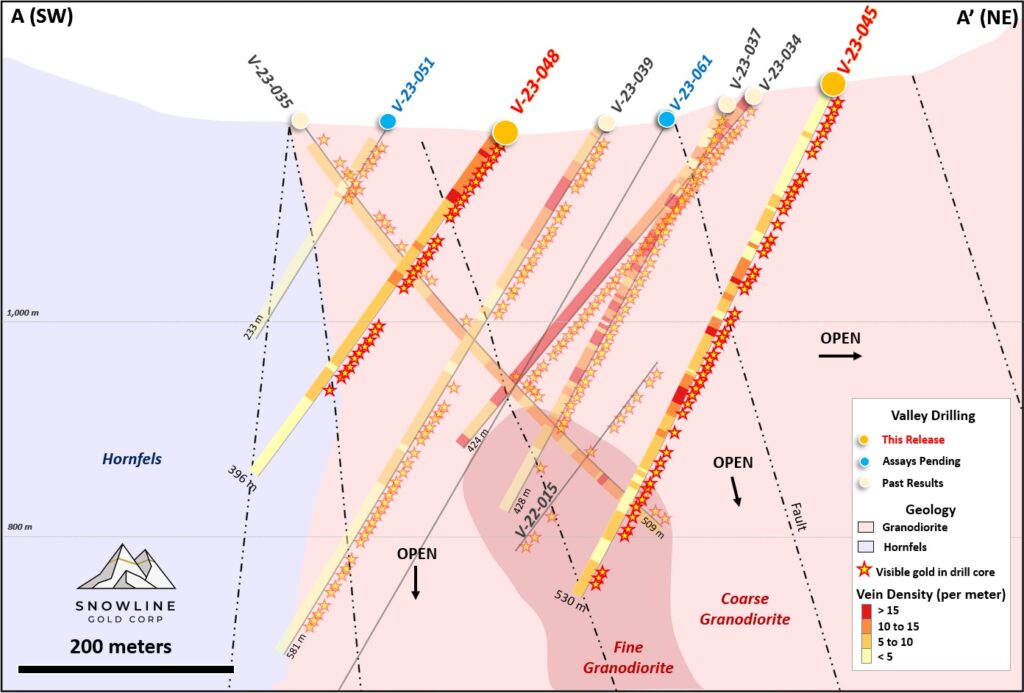
Figure 3 – Cross-section A, showing quartz vein density per metre and instances of trace visible gold observed during logging. Together, vein density and frequency of trace visible gold have shown to serve as a general indicator of grade potential at Valley. Note that in a sheeted quartz vein array like those present at Valley, the angle of veins to core can affect apparent density per metre. Density/visible gold data for V-23-061 not yet available at time of writing, though a select run is shown in Figure 5. This figure complements Figure 1 of this release.
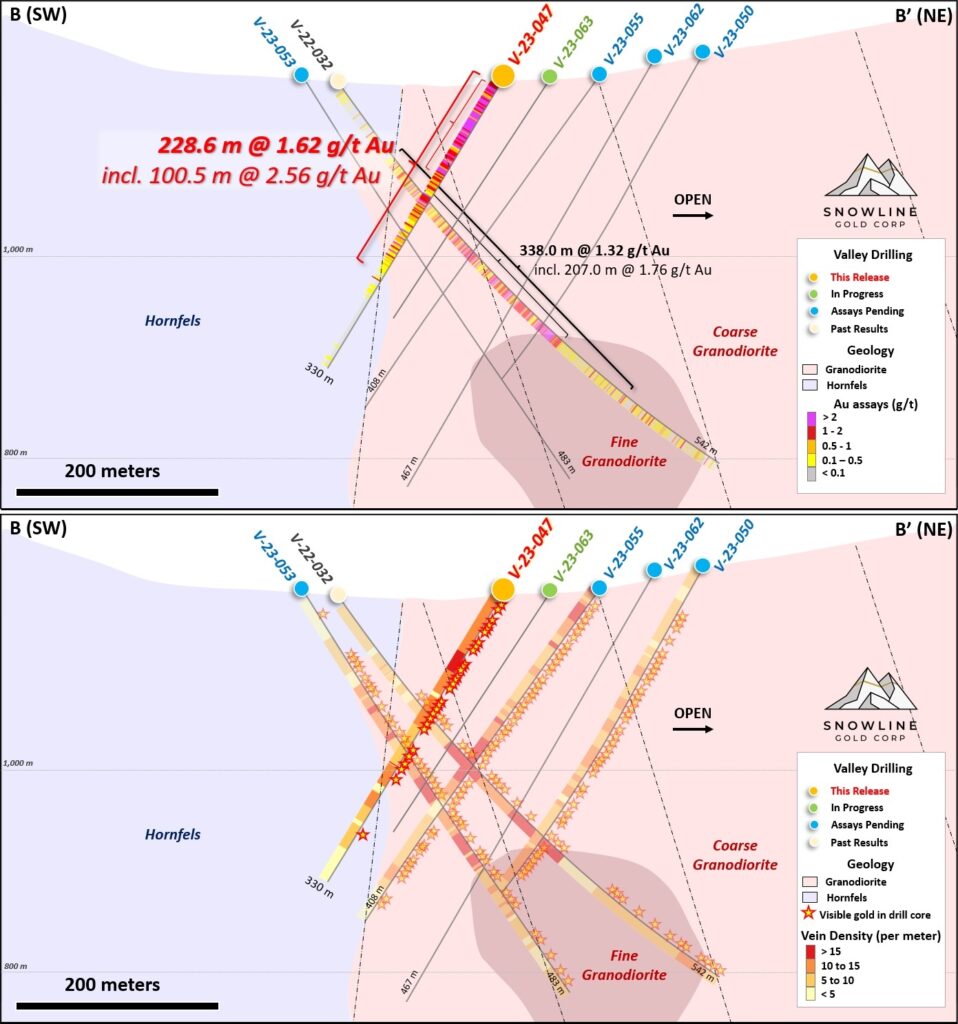
Figure 4 – Cross-section B, showing V-23-047 in the context of surrounding holes and a simplified geological model. Top: Analytical results received to date and still pending (thin black lines). Bottom: Vein densities alongside instances of trace visible gold observed during logging. V-23-047 demonstrates that mineralization seen in V-22-032 continues to surface, with strongest grades near the top of the hole.
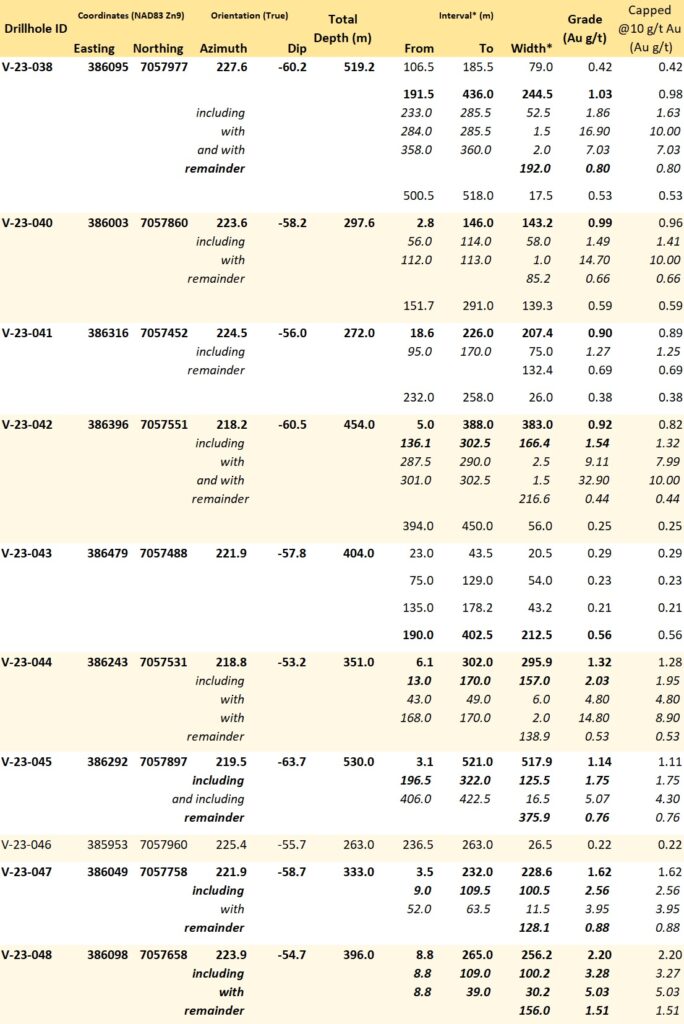
Table 2 – Summary of mineralization observed in current holes. The consistency of strong mineralization is reinforced by the capped values in the rightmost column, wherein any assay result >10 g/t Au is replaced by 10.0 g/t Au to calculate the average interval grades. The high results demonstrate uniform gold mineralization that is not “smeared” across a given interval by isolated high-grade samples. *Interval widths reported; true widths of the system are not yet known, with different vein generations, orientations, and grade distributions present within various intervals through the bulk tonnage gold target at Valley.
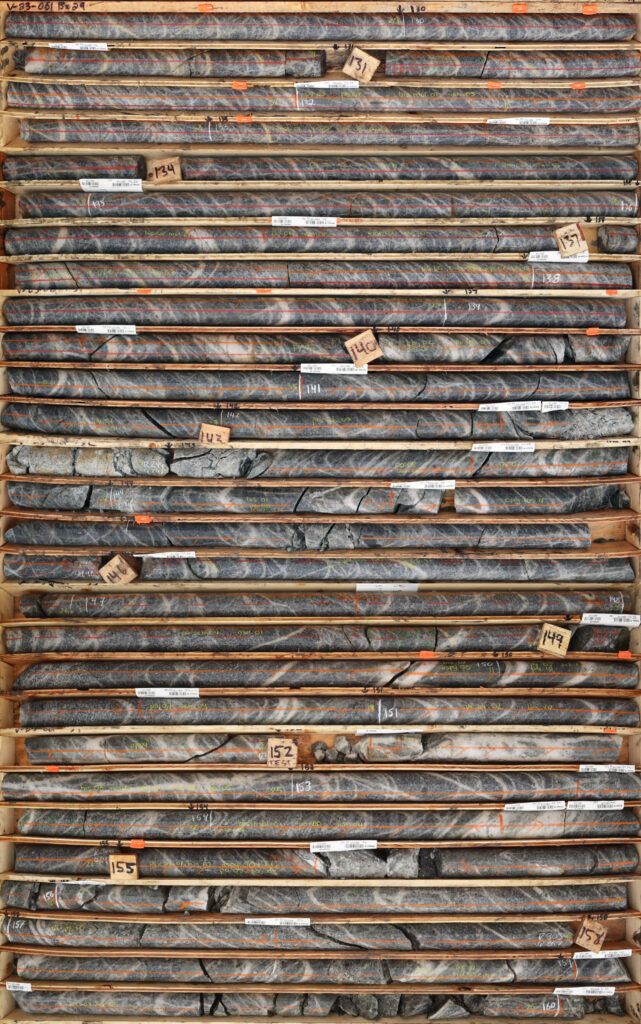
Figure 5 – High quartz vein density observed in V-23-061, from 129.3 m to 160.0 m downhole in a composite photo. Orange flagging tape marks instances of trace visible gold observed during logging. Multiple generations of veins can be seen cutting the core at different orientations. NQ2 sized drill core shown is 5.1 cm in diameter. The above vein densities are not representative of the entire hole. Assays are pending for this section and the remainder of the hole.
EXPLORATION UPDATES
Valley Target Drilling, Rogue Project
The 10,000+ m drill program at the Rogue Project’s Valley discovery is ongoing, with two drill rigs active on site. To date, >13,000 m has been drilled on the Valley target in 2023, with 29 holes completed and an additional 2 holes in progress. This represents more drilling at Valley than the sum of all previous drilling on the target to date. Analytical results for 19 holes drilled at Valley in 2023 are pending. The Company intends to continue drilling at Valley until the end of the exploration season in early October.
Satellite Target Drilling, Rogue Project
Phase II drilling is ongoing at the Rogue Project’s Gracie target, with three holes completed in 2023 and a fourth hole, G-23-009, in progress. At present, >1,800 m has been drilled at Gracie this season. Drilling at Gracie has encountered sedimentary rocks with varying degrees of hornfels alteration, indicating proximity to an intrusion, and low-density sheeted quartz veins bearing rare instances of trace visible gold. The goal of the Phase II drill program is to intersection a causative intrusion for the widespread alteration and mineralization observed in the Gracie target area.
At Reid, as previously described, LM-23-001 intersected a poly-phase intrusive system, with a coarse-grained granodiorite phase and a fine-grained porphyritic phase, and moderate to low vein densities. The hole was called at 623 m depth in coarse-grained granodiorite with low vein densities. A total of 15 instances of trace visible gold were observed in the hole.
A short Phase I drill program was completed at the Cujo target, located roughly 30 km west of Valley. CU-23-001 was drilled to 421 m in an exposure of a granodiorite intrusion with anomalous gold geochemistry. The hole intersected low to moderate densities of sheeted quartz veins. Nine instances of trace visible gold were observed during logging. A second hole, CU-23-002 was initiated but was abandoned due to concerns about pad stability on subsurface ice, and the rig was returned to Valley.
Results are pending for Rogue satellite target drilling.
Southwest Yukon Drilling
At the Tosh Property, the Company recently completed an expanded 6 hole, 1,719 m Phase I program focused on the “Yarrow” gold-silver target, a zone of anomalous soils and rock grab samples associated with mineralized breccias. This program is the first ever drill testing of the Tosh Property.
QA/QC
On receipt from the drill site, Valley’s NQ2-sized drill core was systematically logged for geological attributes, photographed and sampled at Snowline’s 2023 field camp. Sample lengths as small as 0.5 m were used to isolate features of interest, but most samples within moderate to strong mineralization were 1.0 m in length; otherwise, a default 1.5 m downhole sample length was used. Core was cut in half lengthwise along a pre-determined line, with one half (same half, consistently, dictated by orientation line where present or by dominant vein orientation where absent) collected for analysis and one half stored as a record. Field duplicates were collected at regular intervals as ¼ core samples by splitting the ½ core sent for sampling, leaving a consistent record of half core material from duplicate and non-duplicate samples alike. Standard reference materials and blanks were inserted by Snowline personnel at regular intervals into the sample stream. Bagged samples were sealed with security tags to ensure integrity during transport. They were delivered by expeditor to Bureau Veritas’ preparatory facility in Whitehorse, Yukon. Sample preparation was completed in Whitehorse, with analyses completed in Vancouver.
Bureau Veritas is accredited to ISO/IEC 17025 and ISO9001 for quality management. Samples were crushed by BV to >85% passing below 2 mm and split using a riffle splitter. 250 g splits were pulverized to >85% passing below 75 microns. A four-acid digest with an inductively coupled plasma mass spectroscopy (ICP-MS) finish was used for 59-element analysis on 0.25 g sample pulps (BV code: MA250). All samples were analysed for gold content by fire assay with an atomic absorption spectroscopy (AAS) finish on 30 g samples (BV code: FA430). Any sample returning >10 g/t Au was reanalysed by fire assay with a gravimetric finish on a 30 g sample (BV code: FA530).
All standard reference materials and blanks inserted into the sample streams for the two holes returned values within acceptable limits.
For the purposes of this release, mineralized intervals are defined as runs of mineralization with no break >5.0 m assaying <0.1 g/t Au, or continuous subsections thereof.
ABOUT ROGUE
The Valley target on Snowline’s flagship Rogue Project is a newly discovered, bulk tonnage style, reduced intrusion-related gold system (RIRGS), with geological similarities to multi-million-ounce deposits currently in production such as Kinross’s Fort Knox Mine in Alaska and Victoria Gold’s Eagle Mine in the Yukon. Early drill results demonstrate unusually high gold grades for such a system, present near surface across drill intersections of hundreds of metres. Gold is associated with bismuthinite and telluride minerals hosted in sheeted quartz vein arrays within and along the margins of a one-kilometer-scale, mid-Cretaceous aged Mayo-suite intrusion. Valley is an early-stage exploration project without a resource estimate, and while initial results are encouraging, the presence or absence of an economically viable orebody cannot be determined until additional work is completed.
The Rogue Project area hosts multiple intrusions similar to Valley along with widespread gold anomalism in stream sediment, soil and rock samples. Elsewhere, RIRGS deposits are known to occur in clusters. The Rogue Project is thus considered by the Company to have district-scale potential for additional reduced intrusion-related gold systems.
ABOUT SNOWLINE GOLD CORP.
Snowline Gold Corp. is a Yukon Territory focused gold exploration company with an eight-project portfolio covering >333,000 ha. The Company is exploring its flagship >94,000 ha Rogue gold project in the highly prospective yet underexplored Selwyn Basin. Snowline’s project portfolio sits within the prolific Tintina Gold Province, host to multiple million-ounce-plus gold mines and deposits including Kinross’s Fort Knox Mine, Newmont’s Coffee deposit, and Victoria Gold’s Eagle Mine. The Company’s first-mover land position and extensive database provide a unique opportunity for investors to be part of multiple discoveries and the creation of a new gold district.
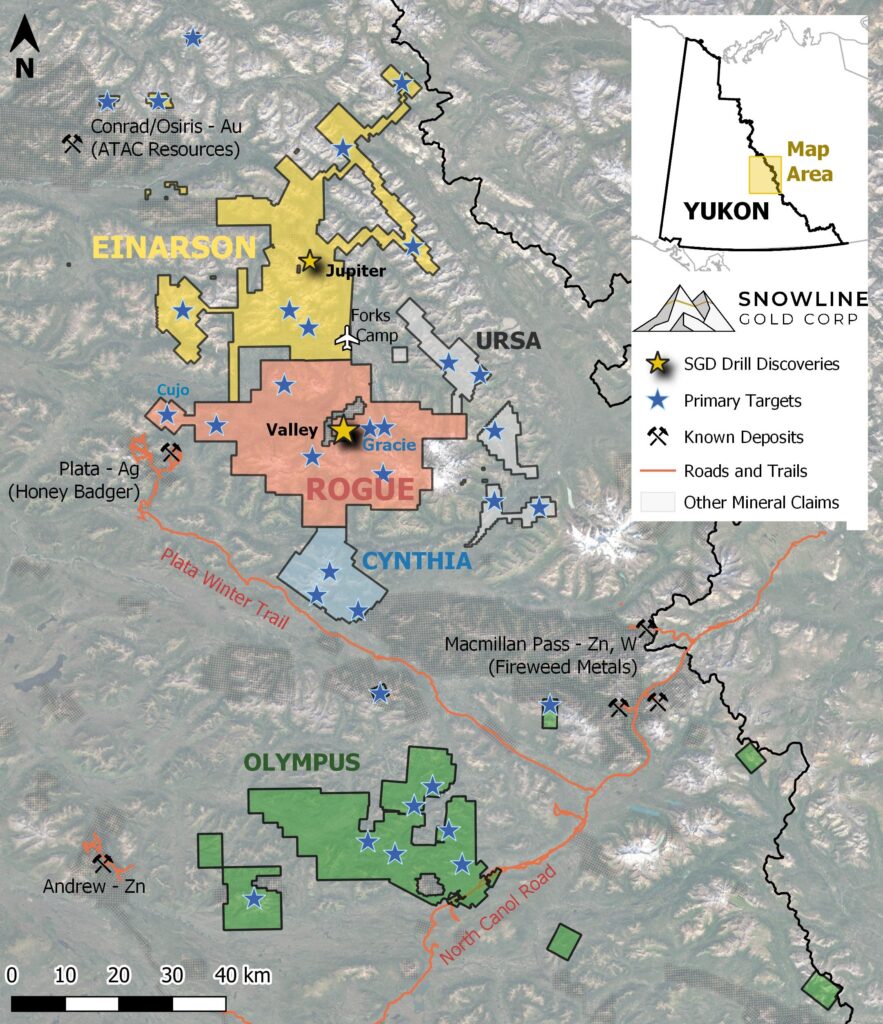
Figure 6 – Project location map for Snowline Gold’s eastern Selwyn Basin properties: Rogue, Einarson, Ursa, Cynthia and Olympus. The current work program at Rogue is based out of the Company’s Forks Camp.
QUALIFIED PERSON
Information in this release has been prepared under supervision of and approved by Scott Berdahl, M.Sc., P. Geo., CEO & Director of Snowline Gold Corp, as Qualified Person for the purposes of National Instrument 43-101.
The 0.64 g/t Au and 0.37 g/t Au average reserve grades at the nearest producing mines referenced in the quotation refer to published reserve grades from Victoria Gold’s Eagle Mine (0.64 g/t Au, as per their 2023 technical report on the Eagle Project), and Kinross’s Fort Knox Mine (0.37 g/t Au, as per their 2018 technical report on the Fort Knox Project). These numbers have not been independently verified by the author.
ON BEHALF OF THE BOARD
Scott Berdahl
CEO & Director
For further information, please contact:
Snowline Gold Corp.
+1 778 650 5485
info@snowlinegold.com
CAUTIONARY NOTE REGARDING FORWARD-LOOKING STATEMENTS
This news release contains certain forward-looking statements, including statements regarding the significance of analytical results, the relationship between vein densities, visible gold and resultant analytical gold grades, the discovery potential within the Valley intrusion, the potential for investors to participate in multiple future discoveries, the Rogue project having district-scale prospectivity, the creation of a new gold district and the Company’s future plans and intentions. Wherever possible, words such as “may”, “will”, “should”, “could”, “expect”, “plan”, “intend”, “anticipate”, “believe”, “estimate”, “predict” or “potential” or the negative or other variations of these words, or similar words or phrases, have been used to identify these forward-looking statements. These statements reflect management’s current beliefs and are based on information currently available to management as at the date hereof.
Forward-looking statements involve significant risk, uncertainties and assumptions. Many factors could cause actual results, performance or achievements to differ materially from the results discussed or implied in the forward-looking statements. Such factors include, among other things: risks related to uncertainties inherent in drill results and the estimation of mineral resources; and risks associated with executing the Company’s plans and intentions. These factors should be considered carefully, and readers should not place undue reliance on the forward-looking statements. Although the forward-looking statements contained in this news release are based upon what management believes to be reasonable assumptions, the Company cannot assure readers that actual results will be consistent with these forward-looking statements. These forward-looking statements are made as of the date of this news release, and the Company assumes no obligation to update or revise them to reflect new events or circumstances, except as required by law.
